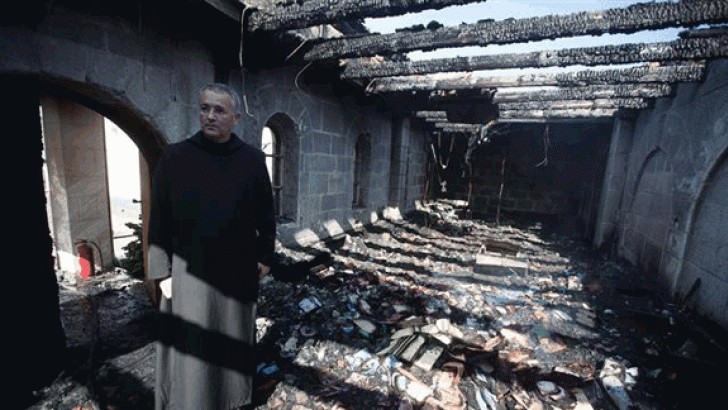Dear friends,
today I am sharing a very good new documentary made by two young American Jewish women, which explores how Israel is taught in American Jewish Day Schools. According to the film makers, Ali Kriegsman and Jana Kozlowski, "Between The Lines offers a deep-dive into how Jewish Day Schools teach Israel's controversial narrative, and the students who emerge with quivering loyalty toward their community and the State. We explore the scope of content offered on Israel's history and the Israeli-Palestinian conflict in various Jewish Day schools across the country."
In the documentary, Kriegsman and Kozlowski seek to explore not only the structure of Jewish day school curricula on Israel and what is and isn't taught about the Israel-Palestine conflict, but also what happens to the students when they go onto college and then feel they were miseducated or undereducated.
What is clear from the documentary is the level of indoctrination about Israel that young American students are receiving is extremely high and that much of the information they are receiving is inaccurate, biased and occurs primarily in order to politically bolster and protect the Israeli state from criticism.
The
makers are Ali Kriegsman and Jana Kozlowski, and they say they want to
motivate Jewish communities around the country, including “synagogues,
camps, schools, programs – to stray from a whitewashed Israel narrative
and instead engage alternative perspectives and current day
complexities, criticisms, and accomplishments.” - See more at:
http://mondoweiss.net/2015/08/student-hysterically-massacre#sthash.amPtBmza.dpuf
Watching the documentary, I was reminded of similar stories recounted to me by many of my American Jewish friends who had become active in Palestine solidarity movement. In particular, it reminded me of a young American Jewish woman I worked with in Palestine several years ago, who story was very similar to many of the young people interviewed in this documentary. This young woman - who has since gone on to become a Rabbi and active in the pro-Palestine BDS campaign - came from a staunchly Zionist family and recounted how during her teenage years she had been active a range of Zionist youth organisations and had regularly visited Israel with her family. Israel was very much central to her life, so much so that she had decided she would make aliyah (ie. migrate and take up Israeli citizenshp). However, all of this changed when she began attending university in Jerusalem.
For the first time every she encountered Palestinian students who challenged the Zionist narrative she had been taught all her life. Speaking with me, this young woman recounted how she got in heated arguments with Palestinians students about Nakba. She refused to believe their account of what happened, refuting that Israel had stolen Palestinian land and had ethnically cleansed Palestinians in 1948. For her Israel was a saviour of people, not an ethnic cleanser. She said it was devastating to be told that Israel had carried out human rights abuses and was not the light unto all nations she had been taught. This began a journey for her, where she started to volunteer with a Jewish peace group to try and learn more. She traveled into the occupied Palestinian territories and began to speak with Palestinians. But still she held her love of Israel.
Then when Israel began bombing Gaza once more, she organised a gathering in her home town in the USA, which involved prayers for peace and included Jewish, Christian and Muslim worship leaders. She was taken to task by her school for doing so. My colleague went on to recount how this propelled her even more into wanting to learn why her community could not bear to engage with anything challenged the dominate Zionist narrative. She explained to me how betrayed she felt, by her school, by her religious teachers, by her family and everyone around her. She felt she had been lied too and deceived and felt a deep sense of betrayal. Eventually, her journey brought to becoming an advocate for Palestine and rejecting Zionism. This caused a major rift with her family, as well as the rest of her community.
I was fascinated by her story and asked if I could interview her for my blog. She agreed. But within months of making the interview with her public, she asked me to remove it. At first, this young woman would not tell why she wanted me to take it down. Her explanation was very confusing. Eventually she admitted that she was being targeted by Zionists at her school, where she was studying to be a Rabbi. They were attempting to get her kicked out of the school and were using the interview she had done with me to try and get her expelled. While I would have liked to have kept the interview on my blog, I also did not want her to have to endure any more harassment during a vital stage of her studies, so I agreed to take down the interview.
Hopefully this new documentary will go someway towards the goals that its film makers have set - to encourage American Jewish high school students to do their own outside learning when it comes to Israel's history and current events; to encourage educators to rethink the curriculum being taught in Jewish Day Schools and Jewish communities to engage with more a critical narrative of Israel rather than continuing to promote a whitewashing of Israel history and actions.
You can check out the website for the documentary by clicking here.
in solidarity, Kim




